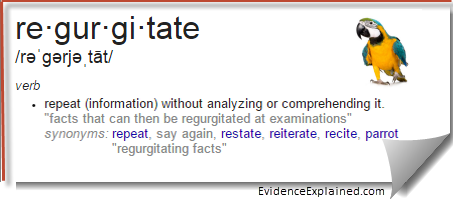Elizabeth Shown Mills

Sometimes, the simplest things are the most confusing. A researcher just asked: "When I'm citing something, when do I use the word citing?" The answer, of course, is It depends.
A few months ago, another EE user approached the question in a different way:
I have a question with regards to citing online images. On p. 605 ... of Evidence Explained, the words "imaged from" appear in place of "citing." Are there times when one would be used instead of the other?1
More recently, a British-based blog addressed the issue this way:
Multi-level citations, indicated by “citing”, give the relationships between derived versions and the original.2
The short response in each case would be this:
- No, the word citing is not the same as “imaged from."
- The word citing might be used in a multi-level citation, but not always.
Words aren't just formalities and citations aren't just formulas. In citations, as in normal language, specific words mean specific things. Logically, when we use citing in a citation, it means The source I have just identified is citing the following as its own source. Just as logically, if our source does not cite its source, then there is no need to use the word citing.
Let’s look at five different situations that involve layered citations and flag the differences between them. (The different layers are distinguished by different colors):
Simple book, imaged online:
1. Samuel Rawson Gardiner, Oliver Cromwell (New York: Charles Scribner’s Sons, 1899), 123; digital images, Google Books (books.google.com : 11 April 2015).
Document, imaged online:
2. Robert Coalter affidavit, 1 January 1828, Thomas Dunn file, Revolutionary War Bounty Warrants, Executive Department, RG3, Library of Virginia, Richmond; digital images, The Library of Virginia (http://lva1.hosted.exlibrisgroup.com/F?RN=260231634 : accessed 11 April 2015).
Original record book, imaged online:
3. Vigo County, Indiana, “Marriage Licenses,” vol. 62: 16, Lee Shick–Alice Taylor, 28 March 1923; digital image, Vigo County Public Library, Vigo County Marriage Record Database, 1818–1958 (http://www.vigo.lib.in.us/SPC /marriages/5907/00072A.pdf : accessed 11 April 2015).
None of these situations call for the use of the word citing. In fact, it would be inappropriate (misleading, confusing, etc.) to use the word. In these instances, our first layer identifies the original, and our second layer identifies the website at which we accessed the digital images. There is no layer in which we are simply regurgitating the source-of-the-source data that our own source gave us.
By contrast, in the instance below, our first layer cites a database and the item it provides. The second layer then tells us what the database is citing as its source-of-its-source.
4. South Carolina, “Legislative Papers, 1782–1866,” database, South Carolina Department of Archives and History (http://www.archivesindex.sc.gov/ : accessed 11 April 2015), abstract, petition of Elijah Jefcoat and others, ca. 1811; citing Series S165015, item 00901.
As a final example, QuickLesson 19, “Layered Citations,” has a more complicated three-layer citation that uses the word citing to introduce only the third layer:
5. “Muster Roll of the Field Staff and other Commissioned Officers in Colonel Goose Van Schaick’s Battalion of Forces raised in the State of New York and now in the Service of the United States of America, Dated in Barracks, Saratoga, December 17 1776,” for Daniel Budd, Adjutant; consulted as “Revolutionary War Rolls,” digital images, Fold3 (http://www.fold3.com: accessed 11 April 2015), images 10188247, 10188258, and 10188267; citing Revolutionary War Rolls, 1775–1783, National Archives micofilm publication M246, roll 77.
Perhaps the key to clarifying when and where to introduce data with the word citing is that word regurgitating:
- If we have used the original document (or an image of it) in a context in which the original identifies itself or the owner-archives has provided a complete citation, then we provide that source data and, if necessary, the published medium through which we viewed the image.
- If we are simply regurgitating the source-of-the-source data given by an online provider of images (or individual author), then after we have identified what we have used, we add the source-of-the-source data that our provider provides. By prefacing those details with the word citing, we are telling the world (and ourselves at a later date): "This is what my provider says about the source, but I don't know the authenticity of these citation details. I am simply regurgitating what my provider is citing."
PHOTO CREDITS: Definition by Google (http://bit.ly/1CZr1qo : 9 April 2015); graphic constructed by Evidence Explained using licensed parrot image from Imsi, MasterClips: 303,000; Design Guide & Image Catalog (N.p.: n.p., 1998).
1. “Citing Online Images—‘Citing’ or ‘Imaged from’?, Evidence Explained: Citation Issues Forum (https://www.evidenceexplained.com/content/citing-online-images-citing-or-imaged : posted 19 July 2013).
2. Sue Adams, “Hierarchies Help Source Organisation, Analysis and Citation,” Family Folklore Blog (https://familyfolklore.wordpress.com/2015/03/21/hierarchies-help-source-organisation-analysis-and-citation/ : posted 21 March 2015), 2nd paragraph under graphic “Claverley marriage register & derivative sources.”
Posted 11 April 2015